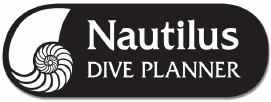
2525
2525
25
VERSION 1.0 VERSION 1.0
VERSION 1.0 VERSION 1.0
VERSION 1.0
eggs. The idea was to design a program that could be used
by engineers and diving supervisors as well as researchers
and would not need a programmer as such. This concept
was accepted, and DCAP was developed and acquired
by several major diving research laboratories. A project to
develop deep air tables by one of the DCAP users, the
Swedish Navy, led to a highly reliable matrix that later was
found to work well for trimix diving also. DCAP is the
accronym for Decompression Computational Analysis
Program.
Description of the DCAP program.
Thus DCAP itself is more a tool for generating and analyzing
tables and profiles than it is a specific model. The User
enters a page of instructions, a Basecase file, into a PC
running DCAP. This describes the dive or dives to be done
and gas mixes, profiles, detailed instructions to the diver,
etc. The Basecase also references other files which define
other variables such as units, the computational model, a
matrix of ascent limits or M-values, the format for the
table or tables, and names other output files to be generated
such as graphics or gas loadings; a notebook file can keep
a record of what has been done. These files use diving and
not computer terminology, normally English, but can be
translated into other languages by the user.
A number of models or algorithms are used by
decompression developers, and they are still evolving; some
are better than others. All of them that work rely heavily on
empirical experience. Hamilton-Kenyon’s experience is
greatest with the neo-Haldanian Haldane-Workman-
Schreiner model designated Tonawanda IIa. incorporated
in to NAUTILUS as the Hamilton-Kenyon Model.
Haldane’s concept was that different parts of the body (
compartments ), take up gas at different rates, and this is
limited by perfusion, the blood’s ability to carry gas from
the lungs to and from the tissues (rather than by diffusion
around a capillary). Uptake and elimination between lung
and tissue follows exponential mathematics, which means
simply that the rate of transfer is proportional to the
difference; these rates are defined by half times for each
compartment (often called tissues but they are not
anatomical), the time it takes for half the difference to be
equilibrated (half the remaining difference takes another half
time, and so on). Gas loadings of inert gases are measured
in partial pressures. The original Haldane method provided
ascent constraints as limiting ratios of partial pressures (the
ratio of current depth to target depth). Because this worked
best only for short, shallow air dives, Workman based ascent
constraints on differential pressures. A matrix of maximum
tolerable gas loadings ( M-values ) for each compartment
at each depth defined the ascent limits; the gas loading
calculated for each compartment is compared with the limit
at each depth, and ascent to the next stop is allowed when
the loadings in all compartments are less than the M-values
(the loadings decay exponentially as ambient pressure is
reduced and gases leave the body). Schreiner made this
work efficiently for different inert gases by using different
half times for each inert gas and summing the loadings in
each compartment. Haldane used 6 half times, others use
more, Hamilton-Kenyon use 11 half times.
Since many decompression computations are done
with Bühlmann’s published method, it is relevant to
compare it with Tonawanda Iia. Bühlmann uses a
similar approach, except that instead of a matrix of M-
values it uses factors a and b for each of the half times;
these tolerated pressures can be converted algebraically
to M-values. In the faster compartments (shorter half times)
the inert gases are summed and compared with a calculated
limit, and in longer compartments the different inert gases
have different a and b values; these are divided proportionally
according to the proportion of each inert gas in the mix.
Both methods can vary in their conservatism, but in present
practice the Tonawanda Iia model using the matrix described,
identified as MM11F6, (Hamilton-Kenyon) is a bit more
conservative that the unmodified Bühlmann method. This
combination has worked well with trimix dives. The most
popular use of the MM11F6 matrix has been for the well
known “Key West Consortium Trimix Diving Tables, the
